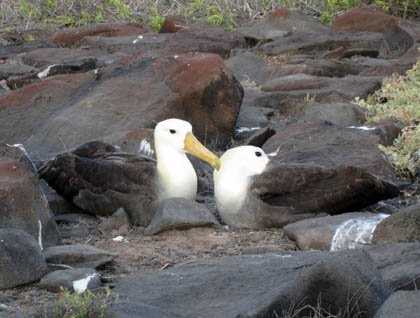Located in the extreme southeast of the archipelago, Española is considered to be the oldest island in Galapagos, at approximately five million years old. It is flat and dry, with no highlands, but with a great endemism and a unique natural history, the result of millions of years of evolution. Before 1892 when Ecuadorian government re-baptized the islands with Spanish names, its English name was Hood Island, after Viscount Samuel Hood.
With excellent weather conditions, clear and calm waters, we loaded our Zodiacs and headed to Gardner Islet, where we started our activities with a snorkeling excursion to discover the incredible underwater world. We observed a huge school of black-stripped salemas, thousands of them almost immobile as they tried to blend in with the rocks and evade predators, such as sea birds. Some green sea turtles and playful juvenile Galápagos sea lion delighted our adventurous guests. After snorkeling, we disembarked on the coralline sand beach of Gardner bay, where we had a great chance to interact with many sea lions that were resting on the beach. Hungry newborn pups moved up and down the beach, searching for their mothers. Females promptly and vocally denied any access to pups that are not their own, while large bull sea lions patrolled their territories. Along the beach, Española mockingbirds flitted about the beach, digging in the sand and producing their unmistakable calls. It was very interesting to see their unique behaviors, especially when they began to fight, attacking each other in groups like real gangs marking territories, regardless of people close to them.
We finished the activities of the morning with a kayaking excursion along the coast of the island. The National Geographic Endeavour was repositioned at the westernmost point of Española, known as Punta Suarez. It contrasted completely with Gardner Bay beach; rocky terrain, boulders and dry vegetation with unique species created a unique world in this remote part of the planet. As we ventured along the path, we had to step over marine iguanas that were warming their tepid bodies after a foray into the cool waters to feed upon algae. Nazca boobies awakened our senses with a high-pitched screech while flying overhead searching for nesting areas along the cliffs. During this dry season, matted dry grass and skeletal croton bushes surround the boulders on the path. Mockingbirds followed us, looking for any opportunities to find some food or water. As we arrived at the cliffs, we had our first encounter with the biggest sea bird of the archipelago, the waved albatross. We saw a few chicks and juveniles, one abandoned egg and many adult albatrosses displaying their elegant and unique courtship dance, which consisted of a combination of beak “jousting,” neck swaying, sky pointing, and deep calls. These majestic birds soared by as they searched for their chicks among the colony, eventually landing haphazardly on the ground. We finished our hike, tired but happy because today was an excellent day in this magical place called Galapagos.







